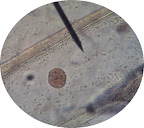Viewing Plant Cells Teacher's Guide
Prelab Preparation
Onions can be prepped beforehand using an onion you buy at a grocery store. You can also demonstrate removing the sliver of skin needed to place on the slide and have students remove it themselves. This would require more onions but you can cut it into quarters. I prefer this method, but it does take more time and you might want to have convenient sinks.
Elodea can be obtained from biological supply companies or from fish stores. Some states restrict this plant though. You can substitute with other aquarium plants, the trick is to get a plant with a very thin cuticle so that the cells are visible. I grow elodea in a jar and keep it year after year.
Prelab Questions:
1. What is the function of the chloroplasts? capture light for photosynthesis
2. Name two structures found in plant cells but not animal cells. chloroplasts, cell walls, central vacuole
3. Name three structures found in plant cells AND animal cells. nucleus, cell membrane, cytoplasm, endoplasmic reticulum, golgi apparatus, ribosomes
4. What structure surrounds the cell membrane (in plants) and give the cell support? cell wall
Part A - Onion Cells
Obtain a prepared slide of the onion cells and view under scanning, low and high power. Sketch what you see exactly as it appears. On the high power sketch, LABEL the NUCLEUS, CYTOPLASM, and CELL WALL of a single. cell.
Estimate how many cells you can see under low power __8-20____ high power _____1-2_______
Sketches will vary, but you should look for cell scale.



Part B - Elodea Cells
Create a slide with the leaf of an elodea (a water plant, commonly known as water lettuce) and place a cover slip over the specimen. Sketch the leaf as it appears under scanning, low, and high power. On the high power sketch, LABEL the CHLOROPLASTS, CYTOPLASM, CENTRAL VACUOLE, and CELL WALL of a single cell.
Estimate how many cells you can see under low power _40-200____ high power _4-10____



POST LAB QUESTIONS
1. What did the onion and the elodea have in common? How were they different?
Both have rectangular shapes, the elodea has visible green chloroplasts (and a green color). The onion has a visible nucleus in its center.
2. Why were no chloroplasts found in the onion cells. (hint: think about where you find onions)
Onions are roots, they do not photosynthesize.
3. Which type of cell was the smallest, the onion or the elodea? elodea